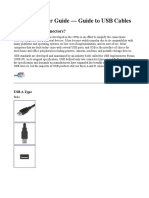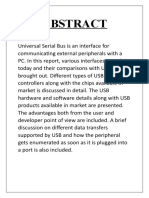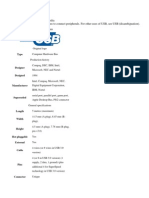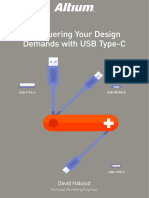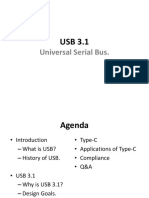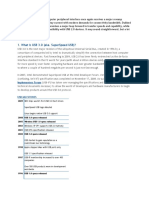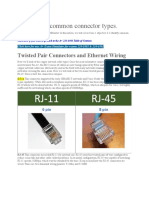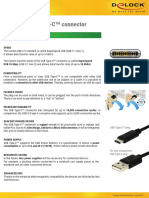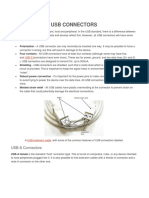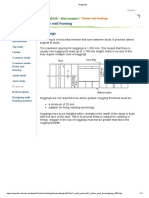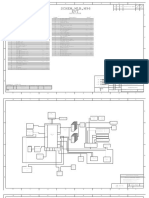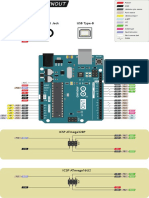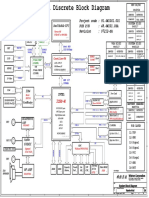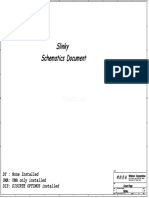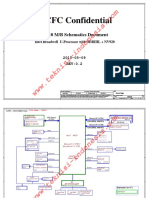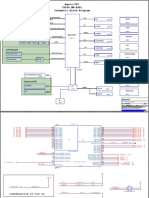USB Connector Type Guide
newnex.com/usb-connector-type-guide.php
Ubiquitous to modern society, USB tech can be found in at least one or more devices
people use on a daily basis. However, USB cables come in a variety of connections, most
of which are incompatible with the others. This makes replacing a USB cable a
troublesome task, especially when the differences between each may seem trivial to the
inexperienced.
For instance, while micro B and mini USBs may use synonymous terms, you cannot
simply use one plug to connect to the other's port. To make matters even more
confusing, the USB tech industry is constantly evolving that even the same plug type can
differ between each version of USB, simultaneously influencing the plug's performance.
We have put together this exhaustive guide to help you untangle all the nuanced
idiosyncrasies between the different types of USB cables on the market.
USB Type A
Also known as USB standard A connector,
the USB A connector is primarily be used
on host controllers in computers and hubs.
USB-A socket is designed to provide a
"downstream" connection intended for
host controllers and hubs, rarely
implemented as an "upstream" connector
on a peripheral device. This is because
USB host will supply a 5V DC power on the
VBUS pin. As such, it is important to
remember while purchasing USB cables it
is safest to make sure at least one of the
plugs is a USB A.
Though not that common, USB A male to A male cables are used by some implementers
to make connections between two USB A style female port. Be aware that typical A-A
cables are not intended for connection between two host computers or computer to hub.
Related Products:
1/9
� USB 2.0 A to B High Flex Cables
USB Type B
Also known as USB standard B connector,
the B style connector is designed for USB
peripherals, such as printer, upstream port
on hub, or other larger peripheral devices.
The primary reason for the development of
USB B connectors were to allow the
connection of peripheral devices without
running the risk of connecting two host
computers to one another. USB B type
connector is still used today, though it is
slowly being phased out in favor of more
refined usb connector types.
Related Products:
USB 2.0 A to B Cables
USB 2.0 A to B Angle Cables
2/9
�USB Type C
USB-C or USB Type-C connector is the
newest USB interface came to the market
along with the new USB 3.1 standard.
Different from previously mentioned USB
A type and B type connector, USB C Type
connector can be used on both host
controller ports and devices which use
upstream sockets. In the last few years a
numbers of laptops and cellphones have
appeared on the market with C style USB
connectors.
USB Type C connector is compatible with
USB 2.0, 3.0, 3.1 Gen 1 and Gen 2 signals.
A full feature USB 3.1 Gen 2 C to C cable is
able to transmit data at maximum 10 Gbps with enhanced power delivery of up to 20V,
5A (100W) and to support DisplayPort and HDMI alternate mode to transfer video and
audio signal.
USB Mini B
3/9
�Similar to USB B type connector, USB
mini B sockets are used on USB peripheral
devices, but in a smaller form factor. The
mini B plug by default has 5 pins,
including an extra ID pin to support USB
On-The-Go (OTG), which allows mobile
devices and other peripherals to act as a
USB host.
Initially, this plug was designed for earlier
models of smartphones, but as
smartphones have become more compact
and with sleeker profiles, the Mini USB
plug has been replaced by the micro USB.
Now, the Mini-B is designed for some
digital cameras while the rest of the mini plugs series have become more of a legacy
connectors as they are no longer certified for new products.
Related Products:
USB 2.0 Mini A to Mini B Angle Cables
USB 2.0 A to Mini B Locking Cables
USB 2.0 A to Mini B High Flex Cables
USB 2.0 Mini B to Mini B High Flex Cables
USB Micro B
The micro USB B connector essentially a scaled down form of the mini USB which
allowed mobile devices to get slimmer while still maintaining the ability to connect to
computers and other hubs.
The micro B type connector holds 5 pins to support USB OTG, which permits
smartphones and other similar mobile devices to read external drives, digital cameras, or
other peripherals as a computer might. Note that to enable OTG feature, special wiring
connection needs to be implemented in the cable assembly.
4/9
�On Oct. 22, 2009, the international
Telecommunication Union (ITU)
announced to include Micro-USB interface
into the Universal Charging Solution
(UCS) that has been adopted broadly by
industry.
Related Products:
USB 2.0 A to Micro B Cables
USB 2.0 A to Micro B Angle Cables
USB 3.0 Type A
Inheriting the same design to the A-Type
connector used in USB 2.0 & USB 1.1
application, USB 3.0 A is also provides a
"downstream" connection that is designed
for use only on host controllers and hubs.
However, USB 3.0 Type A processes
additional pins that are not in the USB 2.0
A Type. USB 3.0 connector is designed to
support 5Gbps bandwidth "SuperSpeed"
data transfer, whereas, lower data rate can
be transmitted with backward
compatibility to USB 2.0 ports. USB 3.0
connectors are often in blue color or with "SS" logo to help distinguish them from
previous generations.
Related Products:
USB 3.0 A to B Active Cables
USB 3.0 A to A Female Active Cables
USB 3.0 A to Micro B Active Cables
USB 3.0 A to Micro B Cables
5/9
� USB 3.0 A to B Cables
USB 3.0 A to A Female Cables
USB 3.0 A to A Cables
USB 3.0 A to Micro B Angle Cables
USB 3.0 A to B Angle Cables
USB 3.0 A to Micro B Locking Cables
USB 3.0 A to B Locking Cables
USB 3.0 A to A Locking Cables
USB 3.0 A to A Panel Mount Cables
USB 3.0 A to 20 Pin Panel Mount
Cables
USB 3.0 A to Micro B Panel Mount
Cables
USB 3.0 A to B High Flex Cables
USB 3.0 A to Micro B High Flex
Cables
USB 3.0 A to Micro B Ultra Slim
Cables
USB 3.0 A to A Water Proof Cables
USB 3.0 Type B
USB 3.0 B-Type connector is designed for USB peripherals, such as printer, upstream
port on hub, or other larger peripheral devices. This connector can support USB 3.0
SuperSpeed application and also carry USB 2.0 low speed data in the same time.
A USB 3.0 B plug cannot be plugged in to a USB 2.0 B socket due to its plug shape
change. However devices with USB 3.0 Type B receptacles can accept mating with
previous USB 2.0 B Type male plugs.
Related Products:
6/9
� USB 3.0 A to B Cables
USB 3.0 A to B Angle Cables
USB 3.0 A to B Locking Cables
USB 3.0 B to B Panel Mount Cables
USB 3.0 A to B High Flex Cables
USB 3.0 Micro B
Also referenced as the SuperSpeed Micro USB B connector, this connector stacks five
more pins on the side of the USB 2.0 Micro B connector to achieve the full USB 3.0
standard data transfer speed. USB 3.0 Micro B connectors are found on hard drives,
digital cameras, cell phones, and other USB 3.0 devices.
A USB 3.0 Micro B male connector cannot be plugged in to a USB 2.0 B socket due to its
plug shape change. However devices with USB 3.0 Micro B receptacle can accept mating
with previous USB 2.0 Micro B male plug.
7/9
�With the growing need of higher data
transfer rates, more industrial applications
such as Machine Vision and 3D imaging
are starting to implement USB 3.0 Micro B
into their system designs. Screw lock
Micro B connectors are often used in
cabling to ensure secure interconnection.
Related Products:
USB 3.0 A to Micro B Active Cables
USB 3.0 A to Micro B Cables
USB 3.0 A to Micro B Angle Cables
USB 3.0 A to Micro B Locking Cables
USB 3.0 A to Micro B Panel Mount
Cables
USB 3.0 A to Micro B High Flex
Cables
USB 3.0 A to Micro B Ultra Slim
Cables
USB 3.0 Internal Connector (20 Pin)
Developed by Intel, USB 3.0 internal connector cables are usually used to connect the
external USB SS ports on the front panel to the motherboard. The 20 pin internal socket
contains two lines of USB 3.0 signal channels, which allows maximum two individual
USB 3.0 ports without sharing one channel data bandwidth.
Related Products:
USB 3.0 A to 20 Pin Panel Mount Cables
8/9
� USB 3.1 Internal Connector
Developed by Intel, USB 3.1 internal
connector cables are designed for
connecting motherboard to front panel
USB ports.
Similar to previous USB 3.0 internal
connector, the new generation internal
connector also has a 20 pin header
version that support single Type C port or
dual Type A connections but with a
reduced form factor and stronger
mechanical latch design. An 40 pin
header version internal connector was
also introduced to support two full
feature Type-C ports.
9/9

